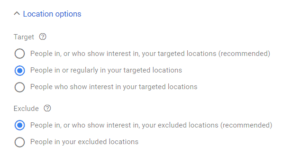‘Twas the night before Christmas and on the internet,
e-Commerce flowed for those whose shopping wasn’t complete yet.
The Google Ads were hung by the Engineers with care,
In hopes that Great Sales would soon hang in there.
The Google Marketers were nestled, all snug in their beds.
While visions of Quality Traffic danced in their heads.
We had just settled our brains for a long winter’s nap.
While automation rules rolled out new bidding caps.
When out on the ‘net there arose such a clatter.
I sprang to my Surface to see what was the matter.
With coffee in my hand and my keyboard at the ready.
I gazed unto my screen and held myself steady.
And, what to my wondering eyes should appear?
But, Saint Google and eight Google Ad Engineers.
They sprang to their desk and opened their code,
Exposing the luster of embedded objects below.
The code flew with such fury that smoke arose from the editor.
As the compiler released new features that were oh so much better.
We watched in wonder as my browser reloaded.
Improved performance, in my diary, I noted.
Saint Google sprang to the sleigh and to his team gave a whistle.
And Engineers flew towards the sleigh like heat-seeking missiles.
Taking their seats with masks on and excitement anew.
They logged in and flew back to Mountain View.
I heard them exclaim, ‘ere they drove out of sight
“Merry Googling to all, and to all a Google night!”
Our Wish List
Since 2008, our Google Ads experts have written an open letter to Saint Google. We believe that at least one of Saint Google’s Elves or maybe even the big SG himself reads our blog because we have gotten lots of things that have been in our letters. Regardless, we find this to be a fun tradition for a company that eats, lives, and breathes Google Ads. So here are our 2022 Christmas wishes for Saint Google.
1. Rework Ad Review for Policy Compliance
The current method for ad reviews just doesn’t work. Too frequently ads we make for clients are clearly within Google’s advertising policy and it has become painfully obvious that there are significant training issues with their Google Staff or Google AI. I see this as a significant opportunity for Google. If AI is as powerful as Google (and other cloud competitors claim) what better way to prove this than to show Google’s fellow geeks with a positive and almost immediate response to submitted ads. If ads could be approved in real-time and false-positives reduced I would quickly become a huge Google AI fan.
2. Opting out of Mobile App Placement in GDN
Google loves targeting ads on mobile apps because it enriches Google (their pocketbook) and the inventory for mobile ads placements are almost infinite. We find that Mobile App placements to be of low quality as we suspect many of the clicks on these ads aren’t people with a legitimate interest in your product, many of these we suspect are small children accidentally clicking on these ads trying to get back to their game. For example, if you are building brand awareness for Beer, you do not want your ads showing up on an App frequented by children.
Another placement we do not like is where the opt-out selection is to actually opt-out of ads on apps. This keeps getting moved around and it gets more complicated each year. We would love the ability to opt-out of app ads with just the click of a button.
3. Negative Search Term Tab
One of our company’s biggest strengths is being able to provide our clients with the information to see how well Google views their website, and therefore their Google Business Profile. However, this takes lots of different tools and can be time consuming. One of our wishes from old St. Google would be a Google Asset Health Check– an easy-to-read report that enables business owners to see how Google perceives the usage and inclusion of its different assets (Google Search Console, Google Analytics, Google Tag Manager, etc.). This report would help tell them what they’re doing right and what needs to change in the eyes of Google. Sometimes Google wants us to be mind readers, but this is an area we would prefer not to be.
4. Second Round Of COVID-19 Ad Credits
With the extra revenue that would inevitably come from the Negative Search Term Tab, there is a lot of goodwill and cheer Google can spread to their advertisers. Early last year, Google provided $340 million worth of ad credits to advertisers as part of their commitment to “support SMBs, health organizations and governments, and health workers on the frontline of this global pandemic”. Even with the earlier stimulus and relief initiatives such as these ad credits, the reality is that many businesses are still feeling the impact of the disruptions caused by COVID-19. Another ad credit from Saint Google would do a lot to raise goodwill and cheer.
5. Account Suspension Transparency
While we love that Google has detailed policies to help keep their advertising ecosystem safe and Digital Advertising on Google makes up 95% of Google revenues, we realize that this is definitely a revenue source Google would want to protect. On the other side of this coin we work with many small businesses where a majority of their revenues come from their Google Advertising efforts. Losing the ability is essentially a death sentence.
Unfortunately as advertisers, we have consulted several businesses who come to us with an Account Suspension problem. Too often many of these businesses with a suspended account are victims of unorganized or deceitful advertisers or were caught up in lack of training and are now blacklisted.
As a Google Partner there has got to be a better way we can help these businesses who come to us for consulting. If Google ever offers a Google Ads certification course on policy and the best practices for the appeals process, we would be the first to take it.
6. Grade the GDN
The GDN (Google Display Network) is massive and poorly documented. We would like Google the extend the use of Quality Scores and introduce them within GDN to grade website placements. Quality Scores would be calculated by bouncerate, website speed, content relevance, and conversion data. Websites with better quality scores will receive more advertising revenue.
7. Auto-crawl URLs when updated
Last month, Microsoft announced a new update known as IndexNow. What happens here is that when content is published or updated on a website, IndexNow notifies all participating search engines, which significantly decreases the time it takes for new content to Index. However,note that this says “all participating search engines” NOT “all search engines”. At the initial rollout, Google was not part of this, although they have recently confirmed they are in the early stages of testing this out. This would be a timesaver as this would eliminate the added steps of manually requesting for a recrawl anytime any website changes are made.
8. Easier Shopping Campaign Setup
Anybody who has set up a Google Shopping campaign knows that it can be a fairly straightforward process when lumping all your products in one ad group. The difficulty comes when you are trying to separate products by ad group or even campaign. The process is murky at best. When creating an ad group you should be able to choose from your products list which products you want to advertise.
9. VR Advertising
Facebook spent an hour and 12 minutes at 2021 Facebook Connect to announce the Metaverse and VR. It is time to start preparing for VR to be the next advertising medium. Google, what are your plans and how are you going to keep Google Ads relevant in the metaverse?
10. Don’t iOS 14.1 our Android
Google, we love data and being able to serve relevant ads to the right audience. We also believe that much can be learned with Apple’s iOS 14.1 release with the opt-in option for tracking. We agree, people do not want to be spied on but spying is a far cry from audience tracking. Apple could have done a much better job instead of playing into the sensationalism that the media spun off when it comes to privacy. Google, we are looking to you to do a better job here when you begin to roll out your Privacy Sandbox and eventually kill third-party cookies in 2023..
Regifting from the Grinch

This Grinch section is for things that were taken from us that we would like back. The Grinch is an evil, sneaky, and despicable soul that takes control away from us, leaving the human experts handicapped by her user-friendly ways. The Grinch does this in the name of machine learning or privacy, but that does not make the deed any less dastardly. We had it before, and we want it back!
Search Query Data
Last year, Google took away another layer of data from the search query data tab, and with it went a degree of control. Not only would we like this returned, but we also want 100% of the data, which we have never had.
Accelerated Delivery
Accelerated Delivery was put out to pasture or executed depending on the metaphor you like. Either way, it’s gone, and we would like it back. We can see how this change benefits Google by managing the spending rate, but we don’t care. Many of our clients, including us, believe that you should take the traffic when you can get it within a business day. Spreading it out over the day runs the risk of not spending the budget and lowering the total traffic. Google thinks there will be more traffic later, and you pay for it if they are wrong.
Keyword Matching Control
We are old school Google Ads Experts. We LOVE control, and we study our client’s needs much more in-depth than Google ever thought of. We understand the value of the close variant, but we also know the problems it creates. When it comes to misspelling, it is hugely valuable. However, when it jumps to another word because Google thinks they are the same, that is not cool!
Average Position
Google retired this somewhat flawed data point this year, and we hate to see an old friend go. We fully understand the flaws in this data, but it is a useful tool. We know that the new data that replaces it is more accurate, but it is so complicated, and explaining it to the client managers we report to is very difficult.
Target Position
Target position was a control that allowed us to buy only the impressions in which our position was somewhere we wanted. For clients that want to appear only at the top, this was a way to solve that. If the bid qualified for the top position, then it appeared, but never in the lower positions.
Placement Controls
In the olden days, we had the option of “People in the Targeted location” but that went bye-bye. Replaced with the targeting in this dialog, which is not a choice we need. We love the fact that they added people regularly in your targeted location. The issue is that options 1, and 3 are false options. If the person shows interest in the location, a data point without definition, they are part of option 1. So pick it or don’t pick it (option 1 and 3) and you get it either way.
So let’s wrap it up and put a bow on it
We know we are asking for a lot but we are not expecting everything, although that would be great. If there is a Googler that needs a purpose for their 20% time, feel free to adopt one of ours. Call us, and we will be glad to add more detail to any of these ideas.









